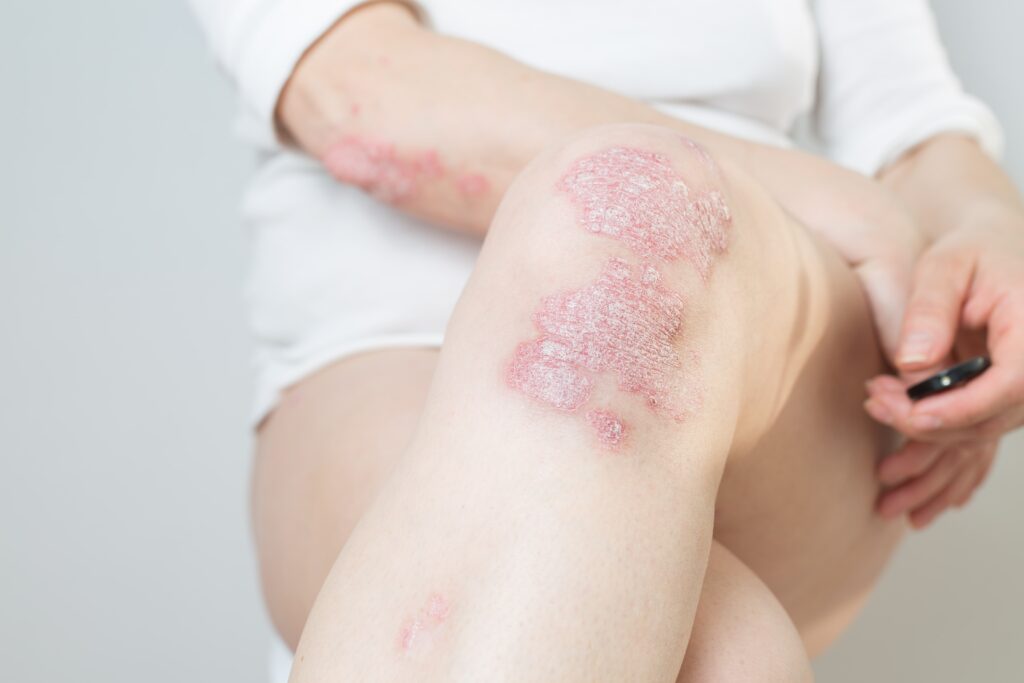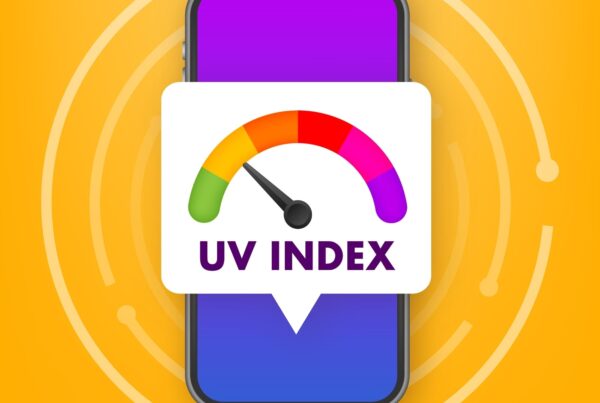Psoriasis is a skin disease caused by immune system dysfunction. While the causes of psoriasis are unclear, the condition’s main characteristic is inflammation. The inflammation can look like raised plaques, scales, or bumps on the skin.
Psoriasis affects about 3% of the US population. This means it is less common than eczema. Psoriasis occurs when an overactive immune system accelerates the growth of skin cells.

While normal skin cells grow, die, and fall off over about a month, psoriasis causes skin cells to grow and die within 3-4 days. Instead of falling off, though, they pile upon the skin’s surface. This leads to flaky, dry plaques.
In severe cases, psoriasis plaques can sting, burn, and itch. They may also appear on any body part and can affect people of all ages.
Over time, psoriatic inflammation can impact other bodily systems, including organs and tissues. About one in three people with psoriasis will also develop psoriatic arthritis, which causes joint pain and stiffness.
If you’re living with psoriasis, you know how difficult it can be to find relief. In his blog, we’ll share some relevant and evidence-based information about the causes of psoriasis, and discuss the treatment options that are most effective for the condition.
What Causes Psoriasis?

Scientists don’t know exactly what causes psoriasis, but they do know that the immune system and genetics are major players.
That said, you can still get psoriasis even if you have no family history of this skin condition. While psoriasis is not contagious, it is usually triggered by something in a person’s environment.
Common triggers include illness (including certain types of strep infections), stress, injury to the skin, and medication. Psoriasis triggers vary from person to person, and can change or fluctuate in intensity over time.
What are the Signs and Symptoms of Psoriasis?
The most common symptom of psoriasis is patches of skin that look and feel dry and are covered in scales.
On darker skin, these patches may look purple or dark brown, while the scales may look gray. On lighter skin, the patches usually look pink or red while the scales are white or silver.
For some people, psoriasis causes unbearable itching or soreness.
The Most Common Types of Psoriasis
There are several different kinds of psoriasis. While most people only experience 1 type of psoriasis at a time, it is possible to develop two different types together.
In some cases, one type changes into another type or becomes more severe over time.
Generally, psoriasis goes through cycles: the condition may cause problems for a series of weeks or months before the symptoms lessen or stop altogether.
With all of that in mind, here’s a breakdown of the most common types of psoriasis:
Plaque psoriasis

Plaque psoriasis is the most common form of psoriasis we know about today. The symptoms of plaque psoriasis are dry skin lesions (known as plaques) which are covered in itchy, flaky scales.
This condition appears most frequently on the elbows, knees, scalp, and lower back, but can exist anywhere on the body. The plaques tend to be itchy or sore and the skin around the joints may crack and bleed.
Scalp psoriasis
Scalp psoriasis is a common type of plaque psoriasis. This condition occurs on parts of the scalp or the whole scalp. For some people, this condition is extremely itchy, while others experience only mild discomfort. In extreme cases, this condition can cause hair loss.
Nail psoriasis
In about 50% of people with psoriasis, the condition is focused on the nails. Nail psoriasis causes the nails to develop tiny pits or dents, become discolored, or even grow abnormally. In severe cases, the nails may crumble or separate from the nail bed entirely.
Guttate psoriasis
Guttate psoriasis is a relatively rare type of psoriasis that tends to disappear on its own after a few weeks. The condition causes small, drop-shaped sores on the scalp, arms, legs, and chest.
Even if the condition disappears, many people who have or had guttate psoriasis go on to develop plaque psoriasis later. The condition is most common in kids and teenagers, and tends to occur after strep throat infections.
Inverse psoriasis
Inverse psoriasis affects the folds or creases of the skin in areas like the groin, armpits, between the buttocks or under the breasts.
It can cause large, smooth patches of skin that are uncomfortable in hot weather or during friction.
Psoriasis Treatment Options and Management Techniques

While psoriasis can cause uncomfortable side effects, there are treatments available.
Some of the most common include the following:
Corticosteroids
Corticosteroids like hydrocortisone ointments are a standard treatment for psoriasis.
These drugs are ideal for mild and moderate psoriasis cases.
Usually, they help resolve plaques on sensitive body parts, like the face or in the skin folds.
Vitamin D analogues
Sometimes, a dermatologist will prescribe synthetic forms of Vitamin D. These medications slow the growth of skin cells. You can use them alone or in conjunction with corticosteroids.
Retinoids
Retinoids are another common treatment for psoriasis plaques, but they’re not a good fit for pregnant people or people who intend to become pregnant.
Light therapy

Light therapy, also known as phototherapy, is a common non-medication option for psoriasis treatment.
Phototherapy treatment exposes affected skin to controlled levels of artificial or natural light. This treatment can provide long- and short-term results.
Prescription medications
If your psoriasis is moderate or severe, your dermatologist may prescribe oral or injected medications to manage your symptoms and decrease side effects.
Skin care regimens
Proper skin care is an effective way to treat psoriasis.
Dermatologists recommend a gentle skin-care routine that includes mild and non-abrasive cleansers, lukewarm water for showers and baths, and gently patting (rather than rubbing) the skin dry.
Patients should also use non-irritating skin care products, avoid the sun, use SPF, and avoid any skincare products that cause stinging, burning, or redness.
Final Thoughts
While psoriasis is a common skin condition, it can be difficult to live with. If you or someone you love has psoriasis, it’s critical to seek dermatological care immediately.
Here at Dermatology Associates, we provide end-to-end treatment for people with psoriasis, from diagnosis to treatment and beyond.
We’ll help you identify your triggers, navigate treatment options, and reclaim your confidence with the healthy skin you desire.
Ready to learn more about our team or how we can help you? Contact us today.





